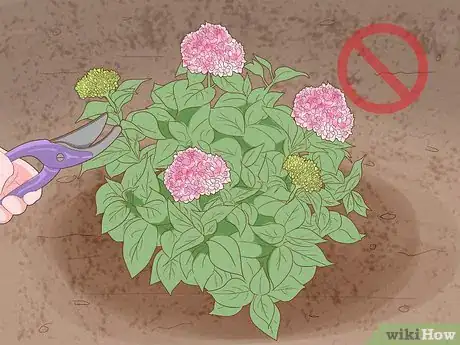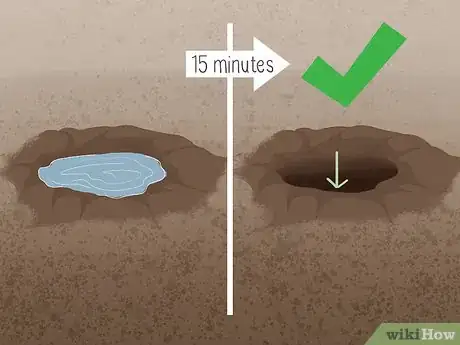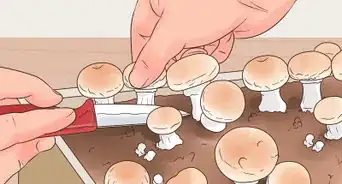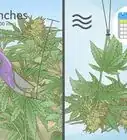This article was co-authored by Rachel Guffey. Rachel Guffey is a Plant Specialist and the Owner of Jungle House, a house plant shop based in Lawrence, Kansas. She specializes in plant education and caring for indoor plants. Rachel is passionate about using plants to help combat seasonal depression. She aims to make plants feel more accessible and approachable to everyone. Rachel has owned over 500 plants at one time.
There are 16 references cited in this article, which can be found at the bottom of the page.
This article has been viewed 75,720 times.
Hydrangea blossoms are beautiful—when they decide to cooperate and actually show up. Some species need year-round care to prevent them from holding a grudge against you and refusing to bloom. Not all flowering issues can be solved during the same growing season, but putting in the work now can give you lovely flower displays for many years to come.
Steps
Expert Q&A
-
QuestionWill hydrangeas bloom indoors?
 Rachel GuffeyRachel Guffey is a Plant Specialist and the Owner of Jungle House, a house plant shop based in Lawrence, Kansas. She specializes in plant education and caring for indoor plants. Rachel is passionate about using plants to help combat seasonal depression. She aims to make plants feel more accessible and approachable to everyone. Rachel has owned over 500 plants at one time.
Rachel GuffeyRachel Guffey is a Plant Specialist and the Owner of Jungle House, a house plant shop based in Lawrence, Kansas. She specializes in plant education and caring for indoor plants. Rachel is passionate about using plants to help combat seasonal depression. She aims to make plants feel more accessible and approachable to everyone. Rachel has owned over 500 plants at one time.
Plant Specialist Keeping a hydrangea indoors and happy can be a difficult task if it's not provided with enough light. I would recommend bright, indirect light indoors — such as a south facing window, or an added grow light). Also, do not allow the soil to dry out completely.
Keeping a hydrangea indoors and happy can be a difficult task if it's not provided with enough light. I would recommend bright, indirect light indoors — such as a south facing window, or an added grow light). Also, do not allow the soil to dry out completely. -
QuestionWhen should I take cuttings?
 NinoxTop AnswererYou can take cuttings from July to September. Remember to only take cuttings from healthy plants.
NinoxTop AnswererYou can take cuttings from July to September. Remember to only take cuttings from healthy plants.
References
- ↑ http://ccenassau.org/resources/-hydrangea-types-and-how-to-prune
- ↑ https://www.rhs.org.uk/advice/profile?pid=516
- ↑ http://www.missouribotanicalgarden.org/PlantFinder/PlantFinderDetails.aspx?kempercode=k520
- ↑ https://extension.uga.edu/publications/detail.html?number=C973&title=Growing%20Bigleaf%20Hydrangea
- ↑ https://extension.oregonstate.edu/gardening/flowers-shrubs-trees/general-care-hydrangeas
- ↑ https://www.missouribotanicalgarden.org/PlantFinder/PlantFinderDetails.aspx?kempercode=d380
- ↑ https://www.missouribotanicalgarden.org/PlantFinder/PlantFinderDetails.aspx?kempercode=c313
- ↑ https://extension.uga.edu/publications/detail.html?number=C973&title=Growing%20Bigleaf%20Hydrangea
- ↑ http://www.missouribotanicalgarden.org/PlantFinder/PlantFinderDetails.aspx?kempercode=k520
- ↑ https://www.missouribotanicalgarden.org/PlantFinder/PlantFinderDetails.aspx?kempercode=d370
- ↑ https://ohioline.osu.edu/factsheet/hyg-1263
- ↑ https://www.chicagobotanic.org/sites/default/files/pdf/plantinfo/hydrangea.pdf
- ↑ https://www.missouribotanicalgarden.org/PlantFinder/PlantFinderDetails.aspx?kempercode=d380
- ↑ http://www.missouribotanicalgarden.org/PlantFinder/PlantFinderDetails.aspx?taxonid=265518
- ↑ https://www.chicagobotanic.org/sites/default/files/pdf/plantinfo/hydrangea.pdf
- ↑ https://www.chicagobotanic.org/sites/default/files/pdf/plantinfo/hydrangea.pdf
- ↑ https://extension.oregonstate.edu/gardening/flowers-shrubs-trees/general-care-hydrangeas
- ↑ https://extension.oregonstate.edu/gardening/flowers-shrubs-trees/general-care-hydrangeas
- ↑ https://ohioline.osu.edu/factsheet/hyg-1263
- ↑ https://extension.oregonstate.edu/gardening/flowers-shrubs-trees/general-care-hydrangeas
- ↑ https://ohioline.osu.edu/factsheet/hyg-1263
- ↑ https://www.chicagobotanic.org/sites/default/files/pdf/plantinfo/hydrangea.pdf
- ↑ https://www.chicagobotanic.org/sites/default/files/pdf/plantinfo/hydrangea.pdf
- ↑ https://ohioline.osu.edu/factsheet/hyg-1263
- ↑ https://ohioline.osu.edu/factsheet/hyg-1263
- ↑ https://hgic.clemson.edu/factsheet/hydrangea/
- ↑ https://extension.oregonstate.edu/gardening/flowers-shrubs-trees/general-care-hydrangeas
- ↑ https://ucanr.edu/datastoreFiles/268-86.pdf
- ↑ https://ag.umass.edu/home-lawn-garden/fact-sheets/growing-tips-hydrangeas-color-fertilizing
- ↑ https://www.purdue.edu/hla/sites/yardandgarden/peeling-sycamore-tree-bark-is-normal-top-heavy-hydrangea-plants-should-i-treat-my-lawn-for-japanese-beetles/
- ↑ https://www.youtube.com/watch?v=QgGcg5uvAyI&t=25s





































































